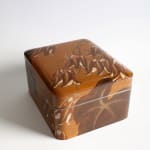Chōhō Narahara
Accessory Box with Design of Gentians and Dragonfly, 1950s
Maki-e colored lacquer on wood, silver rims
Size 6 x 11½ x 9½ in. (15 x 29 x 24 cm)
T-4868
Further images
-
(View a larger image of thumbnail 1
)

-
(View a larger image of thumbnail 2
)

-
(View a larger image of thumbnail 3
)

-
(View a larger image of thumbnail 4
)

-
(View a larger image of thumbnail 5
)

-
(View a larger image of thumbnail 6
)

-
(View a larger image of thumbnail 7
)

-
(View a larger image of thumbnail 8
)

-
(View a larger image of thumbnail 9
)

-
(View a larger image of thumbnail 10
)

-
(View a larger image of thumbnail 11
)

A tebako (accessory box) of standard rounded rectangular form, the inrōbuta (flush-fitting) lid with a narrow chiri-i ledge and slightly domed top, the wood substrate covered in an innovative lacquer...
A tebako (accessory box) of standard rounded rectangular form, the inrōbuta (flush-fitting) lid with a narrow chiri-i ledge and slightly domed top, the wood substrate covered in an innovative lacquer ground typical of work from the mid-twentieth century, decorated in gold and colored hiramaki-e and takamaki-e incorporating passages of lead white with a late-summer composition of leaves and seeds of rindō (gentian) plants, a dragonfly alighting on one of the seed heads, the side with the leaf of another plant, the interior and base finished in polished black roiro lacquer sprinkled with a mixture of flakes of gold and other metals, the rims silver
Signed in gold hiramaki-e on the base: Isao saku (Made by Isao)
A pupil of the distinguished Kyoto lacquerer Ema Chōkan (1860–1940), Narahara Chōho first showed his in public exhibitions in 1934 and became an independent artist three years later. In terms of style, placement of motifs, and choice of subject, this box—probably dating from early in the artist’s career—shows the influence of Akatsuka Jitoku (1871–1936); see Jan Dees, Breaking out of Tradition: Japanese Lacquer 1890–1950, exhibition catalogue, Münster, Museum für Lackkunst, 2020, cat. no. 5.
Signed in gold hiramaki-e on the base: Isao saku (Made by Isao)
A pupil of the distinguished Kyoto lacquerer Ema Chōkan (1860–1940), Narahara Chōho first showed his in public exhibitions in 1934 and became an independent artist three years later. In terms of style, placement of motifs, and choice of subject, this box—probably dating from early in the artist’s career—shows the influence of Akatsuka Jitoku (1871–1936); see Jan Dees, Breaking out of Tradition: Japanese Lacquer 1890–1950, exhibition catalogue, Münster, Museum für Lackkunst, 2020, cat. no. 5.










